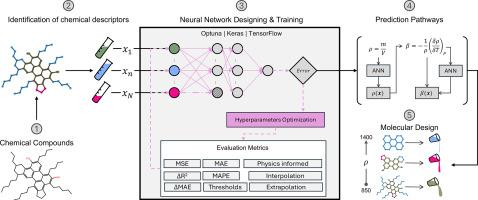Improving the prediction of bitumen’s density and thermal expansion by optimizing artificial neural networks with Optuna and TensorFlow
IF 1.9
Q2 MULTIDISCIPLINARY SCIENCES
引用次数: 0
Abstract
Previous work demonstrated that Random Forest Regressors (RFRs) could estimate the physical properties of bitumen using molecular descriptors derived from Molecular Dynamics (MD) simulations, thereby reducing the need for computationally intensive simulations. However, due to their decision-tree structure, RFRs lack true predictive capabilities, particularly for interpolation and extrapolation beyond the training data.
This study advances that foundation by employing Artificial Neural Networks (ANNs), which—when properly trained—can capture complex relationships with greater continuity and generalizability. Beyond simply replacing RFRs, we develop a fully automated framework for constructing Machine Learning Models (MLMs) to predict density and thermal expansion coefficients of bitumen. Using Optuna for hyperparameter optimization, we ensure that the information extracted from MD simulations is utilized effectively.
The resulting ANN models accurately reproduce MD-predicted densities, achieving R2>0.99, MSEs below 0.1 %, and maximum absolute errors below 5 % on test data. In addition to reducing computational cost, the models exhibit improved interpolation and extrapolation capabilities, enabling reliable predictions for properties, ranges, and compositions not explicitly simulated.
Key aspects of our approach include:
- •Transitioning from RFRs to ANNs, improving generalization, interpolation, and predictive accuracy.
- •Automated hyperparameter optimization, leveraging Optuna to maximize model efficiency.
- •Expanding applicability, enabling property prediction for unseen compositions without additional MD simulations.

通过Optuna和TensorFlow优化人工神经网络,改进沥青密度和热膨胀的预测
之前的研究表明,随机森林回归(RFRs)可以利用分子动力学(MD)模拟得出的分子描述符来估计沥青的物理性质,从而减少了对计算密集型模拟的需求。然而,由于其决策树结构,rfr缺乏真正的预测能力,特别是对于训练数据之外的插值和外推。这项研究通过使用人工神经网络(ann)来推进这一基础,如果经过适当的训练,它可以捕获具有更大连续性和泛化性的复杂关系。除了简单地替换rfr之外,我们还开发了一个全自动框架,用于构建机器学习模型(mlm)来预测沥青的密度和热膨胀系数。利用Optuna进行超参数优化,确保从MD仿真中提取的信息得到有效利用。由此产生的人工神经网络模型准确地再现了md预测的密度,在测试数据上实现了R2>;0.99, MSEs低于0.1%,最大绝对误差低于5%。除了降低计算成本之外,这些模型还展示了改进的内插和外推能力,能够对未显式模拟的属性、范围和成分进行可靠的预测。我们方法的关键方面包括:•从RFRs过渡到ann,提高泛化、插值和预测精度。•自动超参数优化,利用Optuna最大化模型效率。•扩展适用性,无需额外的MD模拟即可实现未见成分的属性预测。
本文章由计算机程序翻译,如有差异,请以英文原文为准。
求助全文
约1分钟内获得全文
求助全文
来源期刊

MethodsX
Health Professions-Medical Laboratory Technology
CiteScore
3.60
自引率
5.30%
发文量
314
审稿时长
7 weeks
期刊介绍:
 求助内容:
求助内容: 应助结果提醒方式:
应助结果提醒方式:


